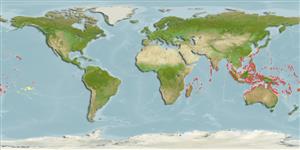>
Blenniiformes (Blennies) >
Blenniidae (Combtooth blennies) > Salariinae
Etymology: Blenniella: Diminutive of blennius, Greek,blenios = mucus (Ref. 45335).
More on author: Bleeker.
Issue
Genus Williams, pers. comm.
Environment: milieu / climate zone / depth range / distribution range
Ekologi
laut berasosiasi dengan karang; kisaran kedalaman 0 - 6 m (Ref. 1602). Tropical; 32°N - 30°S, 37°E - 129°W
Indo-Pacific: east coast of Africa to the Society Islands, north to the Ryukyu Islands, south to about 24°S.
Size / Weight / umur
Maturity: Lm ? range ? - ? cm
Max length : 13.0 cm SL jantan/; (Ref. 9710)
deskripsi pendek
Kunci identifiaksi (pengenalan) | Morfologi | Morfometrik
Duri punggung (Keseluruhan (total)) : 12; duri punggung lunak (Keseluruhan (total)) : 20 - 21; Duri dubur: 2; Sirip dubur lunak: 21 - 22. Distinctive coloration of the head (Ref. 48636).
Adults inhabit clear coastal reef flats, often in exposed habitats, common in outer intertidal reef flats and surge-swept seaward reef; usually where algal growth is prolific (Ref. 48636). They enter small holes, with just its head protruding. They feed on algae and associated detritus and small invertebrates. Oviparous. Eggs are demersal and adhesive (Ref. 205), and are attached to the substrate via a filamentous, adhesive pad or pedestal (Ref. 94114). Larvae are planktonic, often found in shallow, coastal waters (Ref. 94114). Minimum depth of 0 m reported from Ref. 90102.
Distinct pairing (Ref. 205).
Springer, V.G. and J.T. Williams, 1994. The Indo-West Pacific blenniid fish genus Istiblennius reappraised: a revision of Istiblennius, Blenniella, and Paralticus, new genus. Smithson. Contrib. Zool. 565:1-193. (Ref. 9962)
Status IUCN Red List (Ref. 130435)
ancaman kepada manusia
Harmless
penggunaan manusia
Perikanan: tidak ada kepentingan; Akuarium: Komersial
Alat, peralatan
laporan khas
muat turun XML
Sumber internet
Estimates based on models
Preferred temperature (Ref.
123201): 25.4 - 29.3, mean 28.5 °C (based on 2491 cells).
Phylogenetic diversity index (Ref.
82804): PD
50 = 0.5020 [Uniqueness, from 0.5 = low to 2.0 = high].
Bayesian length-weight: a=0.00741 (0.00335 - 0.01640), b=3.02 (2.83 - 3.21), in cm total length, based on LWR estimates for this (Sub)family-body shape (Ref.
93245).
Trophic level (Ref.
69278): 2.5 ±0.19 se; based on food items.
Daya lenting (Ref.
120179): Tinggi, Waktu penggandaan populasi minimum kurang dari 15 bulan (Preliminary K or Fecundity.).
Fishing Vulnerability (Ref.
59153): Low vulnerability (10 of 100).
Nutrients (Ref.
124155): Calcium = 129 [63, 209] mg/100g; Iron = 0.731 [0.420, 1.245] mg/100g; Protein = 18.1 [16.9, 19.2] %; Omega3 = 0.0767 [, ] g/100g; Selenium = 19.1 [9.3, 41.6] μg/100g; VitaminA = 127 [35, 464] μg/100g; Zinc = 2.21 [1.47, 3.17] mg/100g (wet weight);
